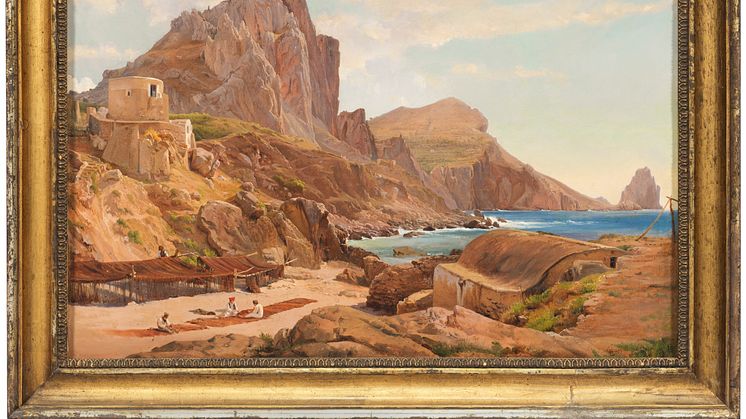
Press release -
New acquisition: Three works by German-Danish artist Louis Gurlitt
Nationalmuseum has acquired three works by the German-Danish artist Louis Gurlitt (1812–97), which between them illustrate different aspects of the artist’s diverse oeuvre. Gurlitt studied in Copenhagen and early in his career was considered a promising figure in Danish painting. By the mid-19th century, however, his name had been erased from Danish art history as a result of the border wars with Germany arising from the Schleswig-Holstein question. Now, he is once again considered a major figure of the Danish golden age, while also embodying its close connections to the German art of the period.
Louis Gurlitt was born in Altona, just west of Hamburg, which until 1864 was the second largest city under the Danish crown. After initial art studies in Hamburg, in 1832 he was accepted as a student by the Royal Danish Academy of Fine Arts, where his teachers included Christoffer Wilhelm Eckersberg. The self-portrait recently acquired at auction in Paris was painted in 1833 by the 21-year-old Gurlitt. It shows a young, self-conscious artist wearing an elegant green painter’s smock to keep spots of oil paint off the neat outfit underneath. That same year, Gurlitt received the academy’s silver medal – an outward expression of the fact that, even while still a student, he was seen as one of Danish art’s great hopes for the future. This was chiefly on account of his landscapes from the Nordsjælland countryside north of Copenhagen.
Wishing to broaden his horizons beyond Denmark, Gurlitt travelled abroad, first to Munich in 1836–37. The German artists of the time were clearly the main role models for his paintings of glorified landscapes and his subtle treatment of light effects. An example of the latter is evident in another of Nationalmuseum’s new acquisitions, a landscape from Berchtesgaden in the Bavarian Alps. The main subject is an old mill supplied with water through an apparently fragile structure. The mill race has sprung a leak at one point, and water is pouring from it to the ground below. Gurlitt subtly captures the cascading water sparkling in the sunlight.
Gurlitt spent the years that followed in Bavaria and northern Italy before returning to Copenhagen, where in 1840 he was made a member of the Royal Danish Academy of Fine Arts. His admission piece, a landscape from Silkeborg in Jutland, was a strategic choice, since Jutland was seen as both exotic and yet deeply Danish. Notwithstanding this and several commissions from King Christian VIII, nothing was able to keep Gurlitt in Denmark. As a German-speaking subject from one of Denmark’s duchies in northern Germany, he could probably sense the rising tide of Danish nationalism. So Gurlitt set course for the south again, heading first to Italy. He was one of a series of colleagues from Copenhagen who sought out picturesque motifs around Rome and Naples. Købke, Petzholdt and Hansen had already painted the magnificent Marina Piccola on Capri before him, yet few artists were as successful as Gurlitt in capturing the subject in all its detail. Through the Danish art trade, Nationalmuseum has managed to acquire one of Gurlitt’s studio versions of this motif, painted in Rome in 1844. Despite the artistic and technical brilliance of this work, Louis Gurlitt remains one of the most underrated landscape painters of the 19th century.
The purchase of these works was made possible by a generous donation from the Wiros Fund. Nationalmuseum has no budget of its own for new acquisitions, but relies on gifting and financial support from private funds and foundations to enhance its collections of fine art and craft.
For more information
Magnus Olausson, Head of Collections and Research: magnus.olausson@nationalmuseum.se, +46 8 5195 4371
Mattias Robertson, Press Officer: press@nationalmuseum.se, +46 767 234632
Related links
Topics
Categories
Nationalmuseum is Sweden’s premier museum of art and design. The collections comprise older paintings, sculpture, drawings and graphic art, and applied art and design up to the present day. The museum building is currently under renovation and scheduled to open again in 2018. In the meantime, the museum will continue its activities through collaborations both in Sweden and abroad as well as temporary exhibitions at Nationalmuseum Design at Kulturhuset Stadsteatern in Stockholm. Nationalmuseum has partnerships with Svenska Dagbladet and the Grand Hôtel Stockholm, and acknowledges the support of FCB Fältman & Malmén.

